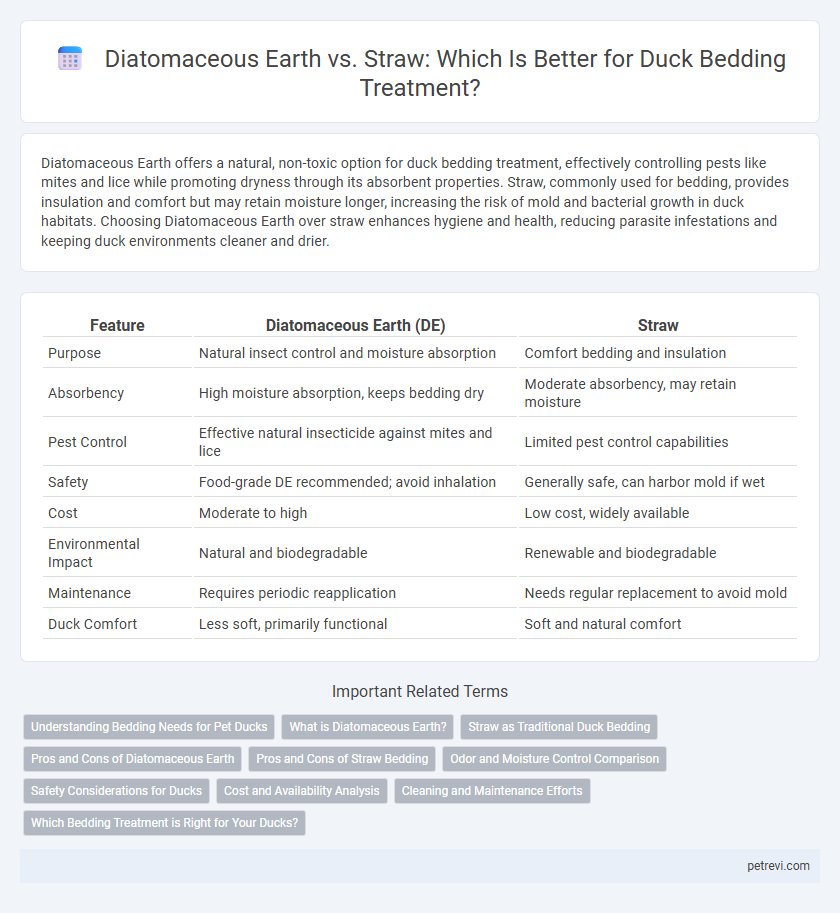Diatomaceous Earth offers a natural, non-toxic option for duck bedding treatment, effectively controlling pests like mites and lice while promoting dryness through its absorbent properties. Straw, commonly used for bedding, provides insulation and comfort but may retain moisture longer, increasing the risk of mold and bacterial growth in duck habitats. Choosing Diatomaceous Earth over straw enhances hygiene and health, reducing parasite infestations and keeping duck environments cleaner and drier.
Table of Comparison
| Feature | Diatomaceous Earth (DE) | Straw |
|---|---|---|
| Purpose | Natural insect control and moisture absorption | Comfort bedding and insulation |
| Absorbency | High moisture absorption, keeps bedding dry | Moderate absorbency, may retain moisture |
| Pest Control | Effective natural insecticide against mites and lice | Limited pest control capabilities |
| Safety | Food-grade DE recommended; avoid inhalation | Generally safe, can harbor mold if wet |
| Cost | Moderate to high | Low cost, widely available |
| Environmental Impact | Natural and biodegradable | Renewable and biodegradable |
| Maintenance | Requires periodic reapplication | Needs regular replacement to avoid mold |
| Duck Comfort | Less soft, primarily functional | Soft and natural comfort |
Understanding Bedding Needs for Pet Ducks
Diatomaceous earth offers superior moisture absorption and pest control, making it a hygienic choice for pet duck bedding compared to straw, which can retain dampness and harbor bacteria. Ducks require bedding that stays dry, reduces ammonia buildup, and provides soft cushioning to prevent foot sores. Selecting diatomaceous earth enhances cleanliness and promotes healthy respiratory conditions, meeting the specific needs of pet ducks more effectively than traditional straw.
What is Diatomaceous Earth?
Diatomaceous Earth (DE) is a natural, silica-based powder made from fossilized remains of diatoms, a type of microscopic algae. It is widely used in duck bedding treatment for its powerful absorbent and natural pest control properties, effectively reducing moisture and deterring mites and insects. Unlike straw, DE provides enhanced hygiene benefits by maintaining a drier environment and minimizing harmful bacteria growth in duck enclosures.
Straw as Traditional Duck Bedding
Straw remains the traditional duck bedding choice due to its natural absorbency and cushioning properties, providing a comfortable environment that helps reduce stress and promote healthy footpads. Its fibrous texture facilitates proper ventilation and moisture control, essential for duck hygiene and minimizing ammonia buildup. Compared to diatomaceous earth, straw is renewable, cost-effective, and supports sustainable farming practices while effectively managing bedding moisture.
Pros and Cons of Diatomaceous Earth
Diatomaceous earth offers exceptional natural pest control in duck bedding by effectively eliminating mites and parasites without harmful chemicals, promoting healthier duck environments. Its absorbent properties help maintain dry bedding, reducing odors and bacterial growth, but it can cause respiratory irritation if inhaled in excessive amounts, requiring careful application and protective measures. Unlike straw, which is biodegradable and comfortable but less effective at pest control, diatomaceous earth provides a potent alternative with some safety considerations for both ducks and handlers.
Pros and Cons of Straw Bedding
Straw bedding provides natural insulation and moisture absorption, creating a comfortable environment for ducks while being biodegradable and easy to source. However, straw can retain moisture if not changed frequently, potentially promoting bacterial growth and increasing the risk of respiratory issues in ducks. Compared to diatomaceous earth, straw lacks insect-repelling properties and requires more frequent replacement to maintain hygiene and prevent odor.
Odor and Moisture Control Comparison
Diatomaceous earth excels in odor and moisture control due to its highly absorbent silica composition, effectively reducing ammonia buildup and keeping duck bedding dry. Straw, while natural and insulating, tends to retain moisture longer, leading to increased odor and a higher risk of bacterial growth. For optimal duck bedding treatment, diatomaceous earth offers superior moisture absorption and odor mitigation compared to traditional straw.
Safety Considerations for Ducks
Diatomaceous earth is a natural, abrasive powder that effectively controls pests but must be food-grade to ensure duck safety, as inhaling non-food-grade particles can cause respiratory issues. Straw bedding provides a soft, absorbent, and safer environment, reducing the risk of dust-related problems and promoting natural foraging behaviors. Prioritizing low-dust, non-toxic materials minimizes respiratory irritation and ensures overall duck health during bedding treatment.
Cost and Availability Analysis
Diatomaceous Earth (DE) for duck bedding costs more per pound compared to straw but offers long-lasting pest control benefits that reduce overall maintenance expenses. Straw is widely available and significantly cheaper, making it a common choice for large-scale or budget-conscious duck keepers. While DE may require less frequent replacement, its higher upfront cost and availability vary by region, whereas straw remains consistently accessible and economical.
Cleaning and Maintenance Efforts
Diatomaceous Earth effectively controls moisture and pests in duck bedding, reducing cleaning frequency and enhancing hygiene by absorbing odors and inhibiting bacteria growth. Straw requires more frequent replacement due to its lower absorbency and tendency to retain moisture, leading to quicker buildup of waste and odors. Utilizing diatomaceous earth significantly decreases maintenance efforts, promoting a cleaner and healthier environment for ducks.
Which Bedding Treatment is Right for Your Ducks?
Diatomaceous earth offers superior moisture absorption and natural pest control, creating a dry and hygienic environment that reduces the risk of mites and bacteria in duck bedding. Straw provides excellent insulation and comfort but retains moisture longer, which may increase the likelihood of odor and bacterial growth if not changed frequently. Choosing the right bedding treatment depends on balancing moisture management with comfort and ease of maintenance for healthier ducks.
Diatomaceous Earth vs Straw for Duck bedding treatment Infographic

 petrevi.com
petrevi.com